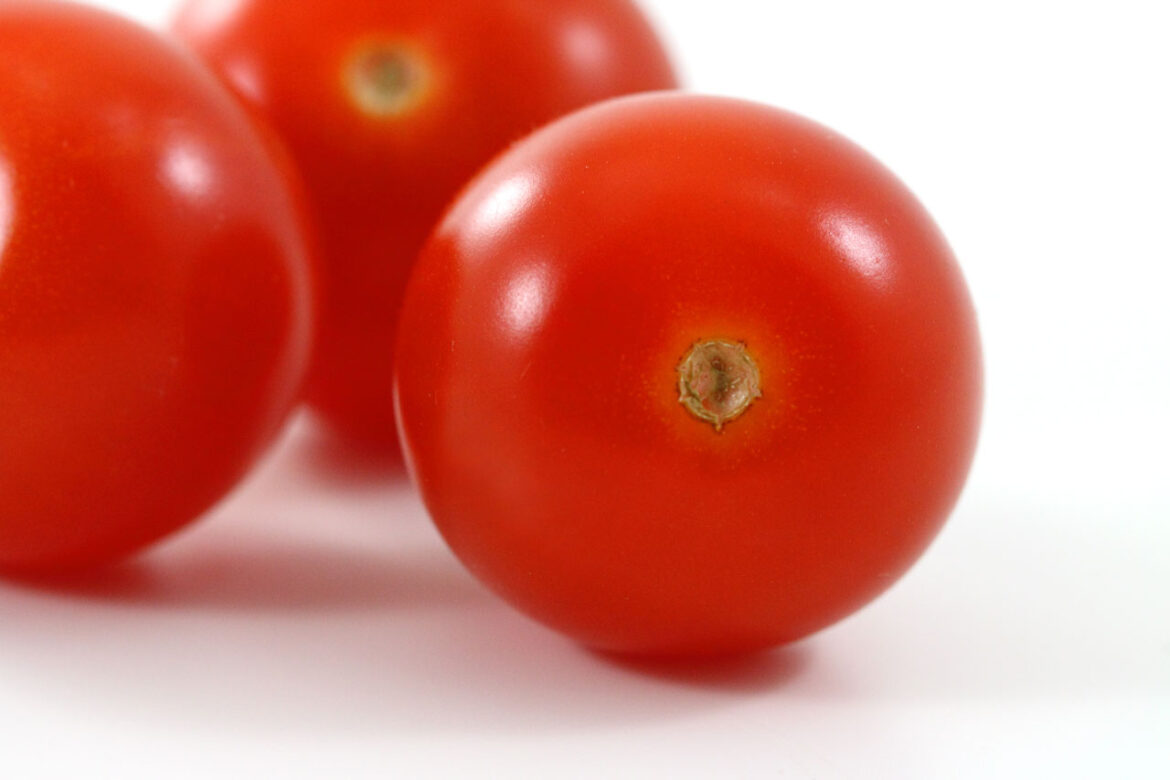Where to grow Tomatoes?
Practically anywhere. The tomato is a warm-weather vegetable, it is very tender to frost and light freezes. The newer dwarf cherry tomatoes are especially suited to growing in tubs and clay pots. Never plant near walnut family trees. The walnut trees excrete an acid that inhibits the growth of nearby plants. Plant basil nearby to repel flies and mosquitoes, and improve flavor and growth.
Bee balm, chives, and mint will also improve health and flavor. Corn and tomatoes are attacked by the same worm, and should not be planted next to each other because of this. Kohlrabi stunts tomato growth. Keep potatoes away also, as they both can get early and late blight. Also, keep cabbage and cauliflower away from your tomato plants.
Recommended Varieties of Tomatoes
There are two basic categories of tomato plants: The determinate, which are genetically controlled and whose terminal buds set fruit and stop the plant from growing (these “bush types” are usually early bearing and do not need staking); and the indeterminate, which are the later-maturing varieties that are taller and usually need some staking.
Because tomatoes have become susceptible to many soil-borne diseases, the modern disease-resistant varieties should be selected whenever possible to avoid crop disappointment. As with any soil-borne plant diseases, rotation of the planting site is also important. (V = verticillium resistant; F = fusarium resistant, N = nematode resistant).
Types of Tomatoes
The recommended early tomatoes include:
- Springset – a determinate variety that takes 67 days to mature from the time seedlings are set out and is resistant to verticillium wilt and fusarium wilt (VF).
- Spring Giant – a determinate variety, 65 days, VF.
- Campbell 1327 – a semi-determinate (grows larger than determinate but does not need staking), 69 days, VF.
Main season plants generally produce larger fruits than do early tomato plants. Brandywine and beefsteak are generically among the most popular varieties. Popular varieties, all indeterminate, include (V = verticillium resistant; F = fusarium resistant, N = nematode resistant):
- Beefeater -75 days, VFN
- Better Boy – 70 days, VFN.
- Burpee’s VF Hybrid – 72 days, VF.
| Temperature | |
| Germination | 60 - 85 F |
| For growth | 70 - 75 F |
| Soil and Water | |
| Fertilizer | Heavy feeder. Fertilizer 1 week before planting. Avoid high N and K at blossom time. Too much leaf growth may indicate too much N or too much water. |
| Side-dressing | Every 2-3 weeks apply light supplements of weak fish emulsion or compost tea. When blossoming, side-dress with a calcium source to prevent blossom end rot. |
| pH | 5.5 - 6.5 |
| Water | Average |
| Measurements | |
| Seed Planting Depth | 1 - 2" |
| Root Depth | 8" - 6' |
| Height (Determinate) | 36 - 48" |
| Height (Indeterminate) | 7 - 15' |
| Width | 24 - 36" |
| Space between plants | |
| In Beds | 18" |
| In Rows | 24 - 36" |
| Space Between Rows | 36 - 72" |
| Average plants per person | 2 - 5 |
| Harvest | |
| Pick when fruit is evenly red but still firm. If warmer than 90F, harvest the fruit either early or late in the day. | |
| First Seed Starting Date: | 28 - 56 days before last frost date |
| Last Seed Starting Date: | 132 - 202 Days before first frost date |
| Companions | |
| Companions | Brassicas, carrot, celery, chive, cucumber, marigold, melon, nasturtium, onion, pea, pepper |
| Incompatibles | Corn, dill, fennel, kohlrabi, potato, walnut |
Soil for Growing Tomatoes
Average garden soil will support a rewarding tomato harvest, but better results are assured if the soil is well prepared with rotted manure, compost, and high-potash fertilizers. Tomatoes are heavy feeders. Plan on providing them fertile, organically enriched soil with a pH between 5.5 and 6.5 to ensure you harvest tomatoes with the best flavor. Fertilizer formulas such as 5-10-10 are good. As an alternative Bone meal or ground rock phosphate are also good soil additions for tomatoes. One basic cause of blossom-end rot is calcium deficiency. Where this disorder has been prevalent, lime the tomato soil at the rate of 5 pounds per 100 square feet. Ground-up eggshells are also good soil supplements to combat this problem.
If possible, dig up your tomato plot in the fall and work it several inches deep, incorporating a 2-inch layer of compost or organic matter into the soil. In the spring rake in a 5-10-10 fertilizer (about 1 pound for 25 feet of row.)
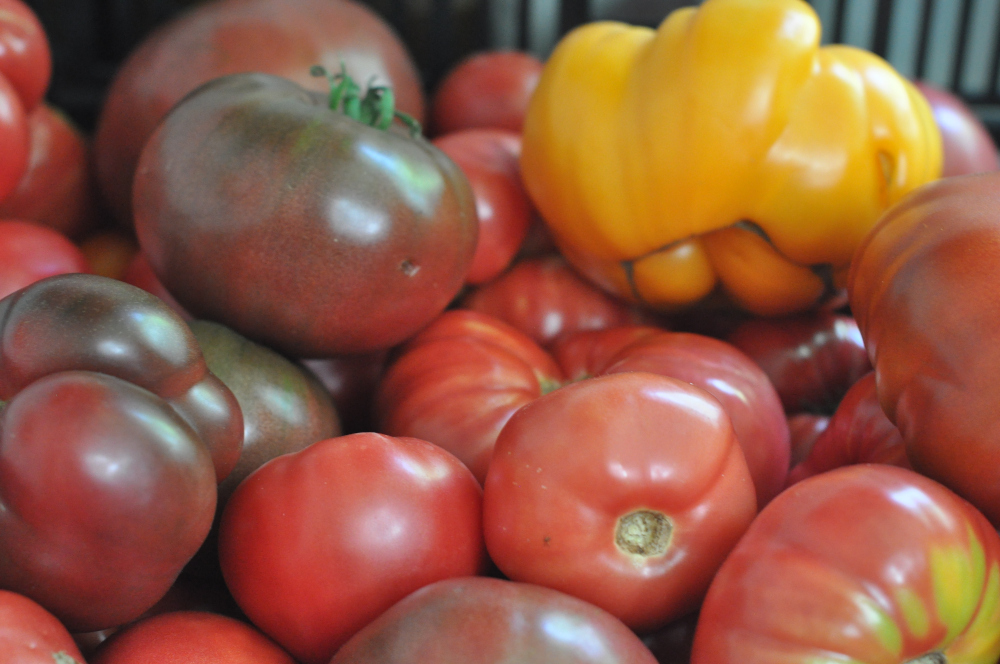
Planting Tomatoes
When –
Tomatoes should not be planted outdoors until day and night temperatures are about 55 degrees. Low temperatures (below 55 degrees) prevent fruit set. Soil temperatures should be at least 55-60F to transplant. Otherwise, plants may turn yellow, become stunted and slow to bear. Seed should be started indoors 6-8 weeks before plants are set out, or use transplants, which are widely available. The ideal plant size is 6-10 inches tall.
How –
To start tomatoes indoors, sow seeds at least 1/2 inch apart, and 1/2 deep in flats or pots about 8 weeks before the last frost date for your area. Seedlings will be spindly with less than 12-14 hours of light per day, try to keep them in a warm sunny location. When seedlings have 4 leaves, transfer to a deeper pot (3-4″) and again when 8-10 inches tall. Each time, place the uppermost leaves just above the soil line and remove all lower leaves. Transplant into the garden when the stem above the soil has reached 8-10 inches tall. Be sure to harden them off before transplanting them outdoors. Allow up to 10 days for the tomato plants to harden off to the outside temperature fluctuations.
Set your seedlings out when the temperatures are fairly certain to be above 55 F throughout the night. Seedlings should be spaced about 2 feet apart for early tomatoes and 3 feet apart for main-season types. Set tomato plants deeply, up to the first set of leaves; roots will form along the stem underground and strengthen the support for the plant. A lanky seedling can be planted on its side, to the first leaves. It will right itself in a day or so. Use a starter solution (half-rate water-soluble fertilizer) when setting out tomatoes to give them a good, quick start. If you do not want to start your own tomato plants, seedlings are available at garden centers or home repair shops. Listen for cold weather warnings; if late frost seems imminent, cover the plants at night with newspaper tents.
How Tomato Plants Grow
The tomato is a vigorously growing plant with attractive foliage resembling the potato, its cousin. The plants have a decided odor caused by gland hairs on the stems and leaves, which give off a strong-scented oil and stain when broken. The fruit is borne on spurs, which develop directly from the stem.
Support structure
Indeterminate tomato plants will need some additional support. Even the determinate varieties can benefit from some of a support structure. The indeterminate types must be tied to their stakes. They have no climbing tendrils so tie them up with soft twine, old nylon stockings, or rags. Make a figure 8 with the tie, looping it around the stake and the plant and tie loosely, or use a slip knot on the stake and use the free ends to tie the plant. There are a variety of support structures available for tomatoes. Probably the most common is the use of a cage in one form or another. It could be made of anything really, use your imagination. Note: If you plan to use a trellis or stakes, set them into the ground before planting.
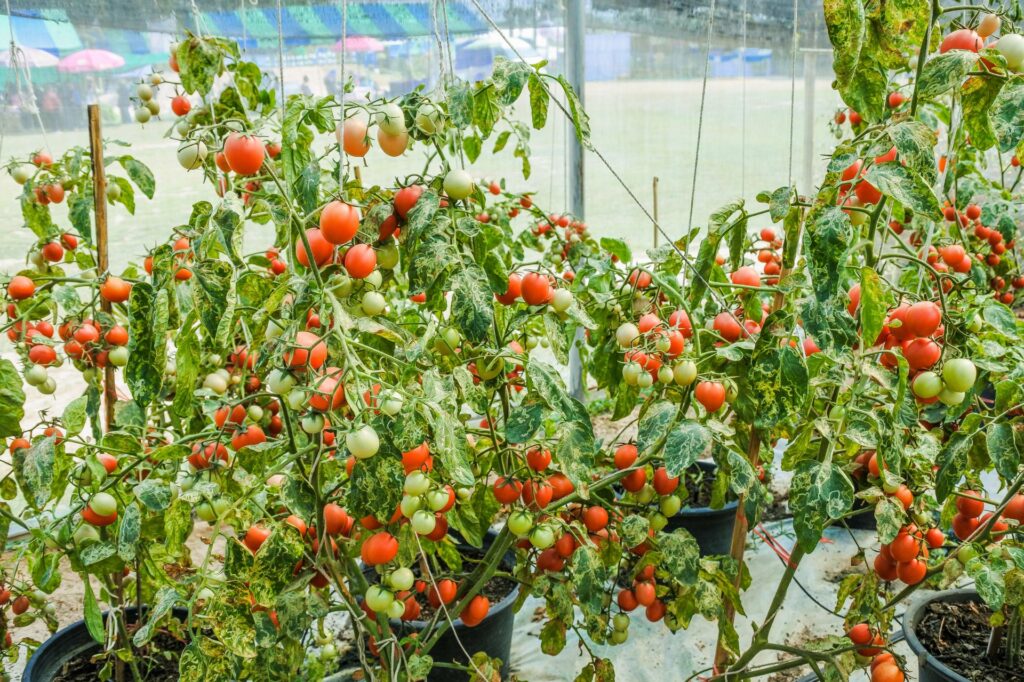
- Cage – To make wire cages, cut 6-inch mesh concrete reinforcing wire, which is 5 feet wide, into lengths about 5 1/2 feet each. Bend each length into a cylinder and fasten securely with wire. Cut off the bottom rung, set a cage over each individual tomato plant, and push the cage into the ground. The plant will grow up through the cage and the fruits will be easy to pick.
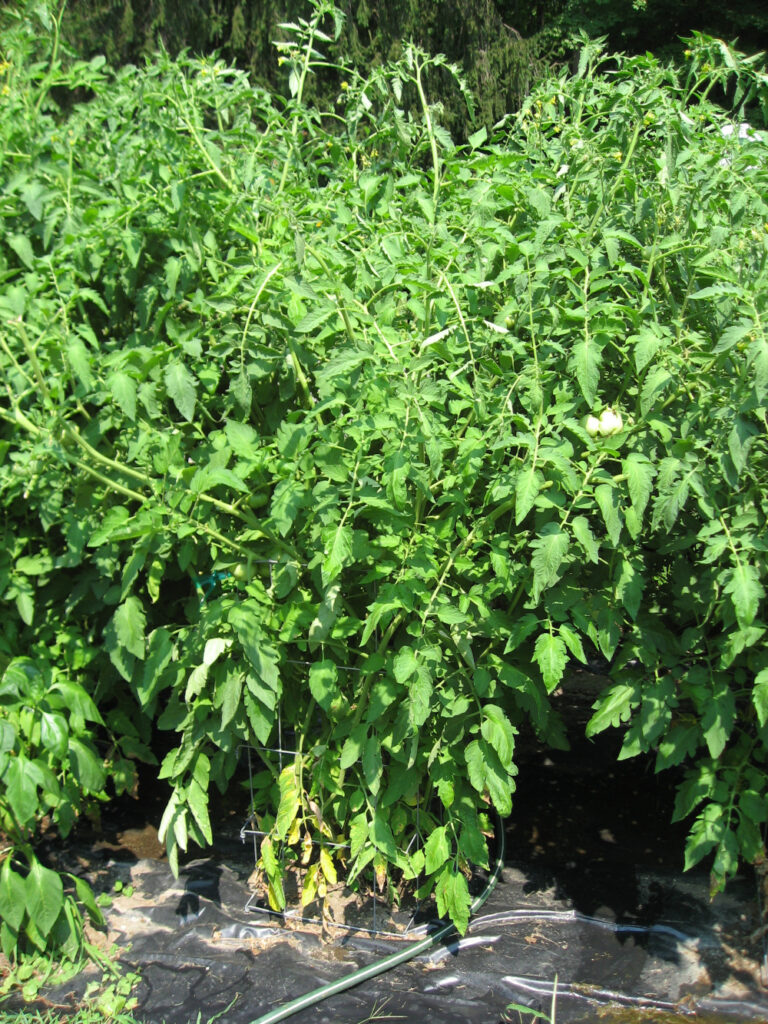
- Pole wire – For a row of several plants, 2 sturdy poles can be placed at the ends of the row and a strong, heavy wire attached to the top of the poles. Heavy twine is then tied to the wire above each plant and pulled down and loosely tied to it. As the stem grows, wind the tomato plant around the twine for support.
- Pole – insert a pole or tall stake that extends about 6′ above the surface of the soil next to each plant. As the tomato plant grows simply tie it loosely to the pole every 6″ or so using a soft twine, cloth, or similar. You could prune any branches that do not conform to the pole.
- Non-staking – Determine plants can be allowed to sprawl on black plastic or thick straw mulch. Set plants 4 feet apart in each direction.
Cultivating Tomatoes
Some sources suggest that indeterminate and larger semi-determinate varieties should be pruned of all suckers (tiny leaves and stems in the crotches of other stems) because they may steal nourishment from the fruits. However, it has been demonstrated that this will limit photosynthetic production, and therefore limit harvest. Leaving these suckers grow should produce more tomatoes as well as an out of control tomato vine.
Feed with a starter solution when the first plants are set out and again after the first flowers form. Continue to supplement with a weak fish emulsion or compost tea every 2-3 weeks. If you do not enrich the soil before planting, feed the tomatoes once a month with about 1/3 cup of 5-10-5 fertilizer scattered in a 2-foot wide band around each plant. Tomato plants need at least an inch of water per week; so water them well, especially during dry spells. If the plants are well mulched, weeds should not be a problem. Try using a plastic mulch in either a red or black color. The mulch will help prevent weeds and keep soil-borne pests from splashing up on the plants, in addition to helping control moisture. A generously moist growing season followed by a severe drought period will often initiate blossom-end rot, which appears first as a water-soaked mark that develops to a flat, dark leathery spot. It can be discouraged with mulching and consistent water levels. Unlike most crops, you may solarize the soil as you grow tomatoes because they’re very heat tolerant. Solarizing helps control disease, particularly verticillium wilt. Wet the soil and cover with clear plastic for the entire season for best results. Hand pollinate in greenhouses.
To keep indeterminate plants from making too much leafy growth, prune them to a single main stem by breaking off side shoots as soon as they appear. You will notice these side “suckers” growing between the crotch formed between the main stem and the leaf stem. Cut them out while they are small. The terminal shoot is pruned off when the plants reach the top of the 5-6 foot stake to stop their growth. These plants are also pruned of suckers, the side shoots that grow between the main stem and the leaf axils to moderate their vegetative growth. Most gardeners prefer to prune their tomato plants to one or two main stems.
| Storage Requirements | ||
|---|---|---|
| Wash and dry before storing. Pack no more than 2 deep | ||
| Fresh | ||
| Temperature | Humidity | Storage Life |
| Ripe : 45 - 50F | 90 - 95% | 4 - 7 days |
| Green : 55 - 70F | 90 - 95% | 1 - 3 weeks |
| Preserved | ||
| Method | Taste | Shelf Life |
| Canned | Excellent | 12+ months |
| Frozen | Good | 8 months |
| Dried | Fair | 12+ months |
Harvesting Tomatoes
60 days (early varieties)
70-80 days (main season)
Pick the fruit when it is red ripe, and check the plants every few days when the harvest starts coming. Store excess tomatoes in the refrigerator, but the flavor is best at room temperature. Tomato flavor starts to decline at temperatures below 55 degrees. When frost threatens, pick the remaining green tomatoes, wrap them in newspaper, and keep them in a moderately dark, warm place. They will ripen gradually well past the harvest season. Given warm weather and abundant rainfall, tomatoes ripen in 60-85 days from the time seedlings are set out. When the fruits begin to turn red, check the plants every day and pick those that are fully red and firm, but not hard. Overripe tomatoes will fall off the plant and rot quickly. To store an abundance of tomatoes at the end of the year, you can roast them, and store in a little olive oil in the refrigerator.
A very light frost will usually kill a few leaves, but the plant itself will continue to grow and produce. However, anything more severe than a touch of frost is likely to kill the entire plant. If frost is coming you can protect each plant by draping it in plastic sheeting or old bedsheets, or you can pull the plant up by its roots and hang in the basement until the fruit ripens. Neither method is guaranteed to work, and in cool areas, an early frost almost always means the end of harvesting tomatoes.
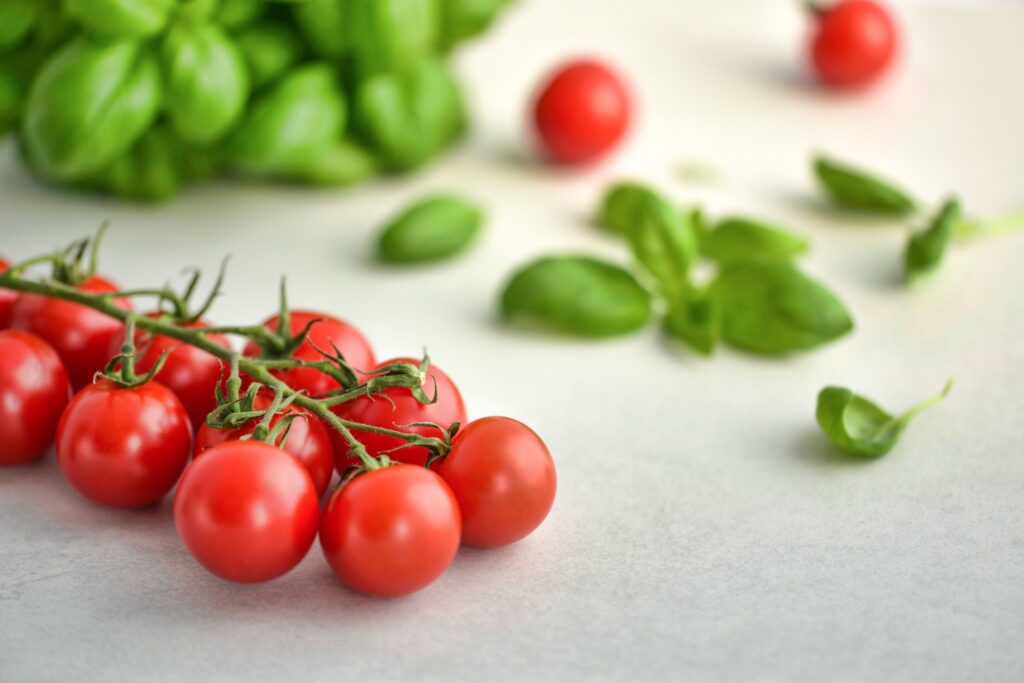
To save seeds from open-pollinated varieties, allow perfect fruits to ripen until they become soft. Cut them in half and squeeze the gel and seeds into a jar. Cover with 3 inches of water and shake well. Allow the mixture to sit at room temperature for 24 hours before pouring out the liquid. Discard the floating seeds, and rinse the larger seeds on the bottom in a strainer and then dry them at room temperature for approximately 2 weeks. If handled and stored properly in a cool dark place, tomato seeds can last up to 6 years.
Tomato Pests
- White fly – Try to be alert to buying clean transplant stock. Vacuuming and high pressure hosing early in the morning can help control populations. Floating row covers can offer a preventive measure. They make a yellow sticky trap for white flies, they are attracted to the color yellow. To minimize their migration to your garden, do not wear yellow clothing while tending your garden.
- Tomato hornworm – large, green caterpillars with white stripes are the larvae of a large moth. Handpick. Planting borage among your tomato plants will keep the hornworms away.
Tomato Diseases
- Wilts, blights – Select a disease resistant variety; rotate tomato soil.
- Early blight develops in early summer and causes leaves near the ground to develop dry, brown patches surrounded by concentric black rings. The best intervention is to prune off all affected leaves as soon as the problem is noticed. Pruning leaves to 18 inches from the ground will also reduce outbreaks.
- Late blight may strike following a prolonged period of heavy cool rain. Affected leaves develop light brown, water-soaked patches, and entire plants can wilt within a few days. Provide excellent light penetration and air circulation to keep plants dry, reducing the risk of late blight.
- Blossom-end rot – Add calcium to the soil; keep plants watered and mulched.
Hard black or brown patches on the blossom ends of ripening tomatoes indicate a physiological disorder called blossom end rot, which is most common in large-fruited varieties. Prevent this problem by growing tomatoes in fertile soil generously enriched with compost and mulch heavily to keep soil moisture levels constant.
Question and Answer
Q: What exactly are Heirloom plants?
A: Heirloom plants are species that have been grown organically, or true to type from seed. Before the industrialization of agriculture, this was the main way to grow plants. This term would, however, rule out any hybrids. As near as gardeners can tell, 1951 is considered to be the latest year a plant could have originated and still be called an heirloom since that year marked the introduction of the first hybrid varieties of vegetables.
